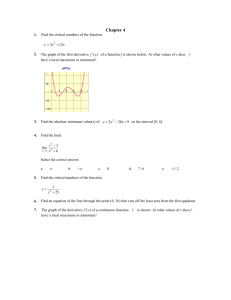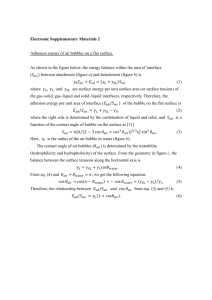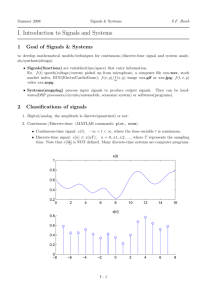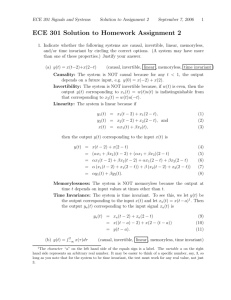Signals and Systems 01
advertisement
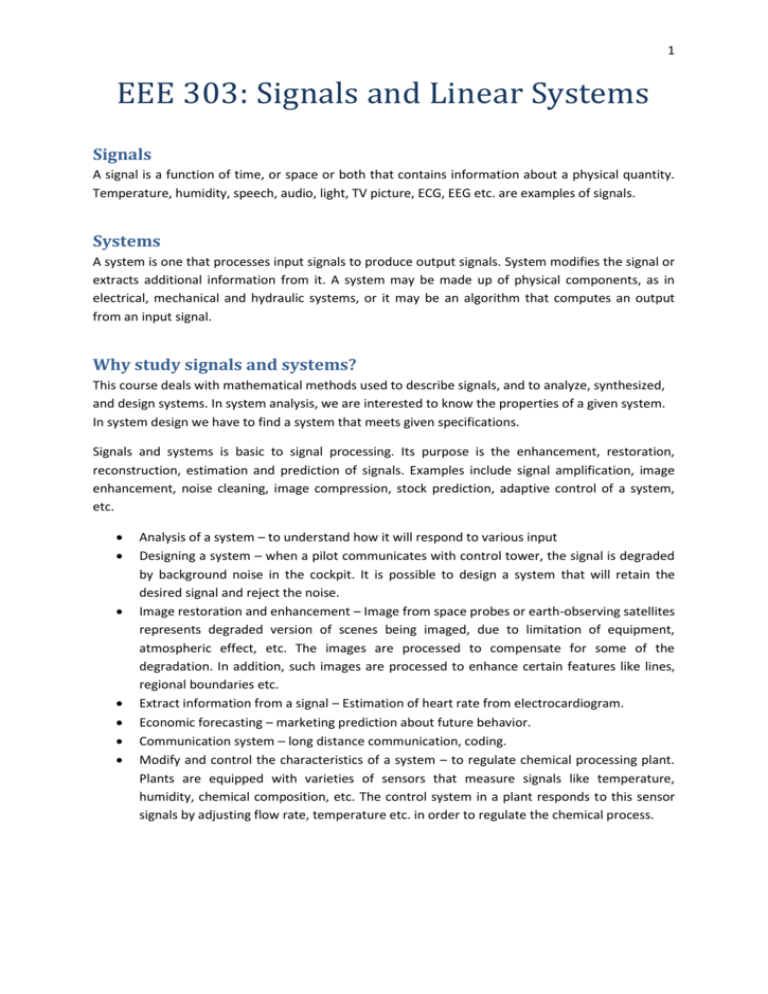
1
EEE 303: Signals and Linear Systems
Signals
A signal is a function of time, or space or both that contains information about a physical quantity.
Temperature, humidity, speech, audio, light, TV picture, ECG, EEG etc. are examples of signals.
Systems
A system is one that processes input signals to produce output signals. System modifies the signal or
extracts additional information from it. A system may be made up of physical components, as in
electrical, mechanical and hydraulic systems, or it may be an algorithm that computes an output
from an input signal.
Why study signals and systems?
This course deals with mathematical methods used to describe signals, and to analyze, synthesized,
and design systems. In system analysis, we are interested to know the properties of a given system.
In system design we have to find a system that meets given specifications.
Signals and systems is basic to signal processing. Its purpose is the enhancement, restoration,
reconstruction, estimation and prediction of signals. Examples include signal amplification, image
enhancement, noise cleaning, image compression, stock prediction, adaptive control of a system,
etc.
Analysis of a system – to understand how it will respond to various input
Designing a system – when a pilot communicates with control tower, the signal is degraded
by background noise in the cockpit. It is possible to design a system that will retain the
desired signal and reject the noise.
Image restoration and enhancement – Image from space probes or earth-observing satellites
represents degraded version of scenes being imaged, due to limitation of equipment,
atmospheric effect, etc. The images are processed to compensate for some of the
degradation. In addition, such images are processed to enhance certain features like lines,
regional boundaries etc.
Extract information from a signal – Estimation of heart rate from electrocardiogram.
Economic forecasting – marketing prediction about future behavior.
Communication system – long distance communication, coding.
Modify and control the characteristics of a system – to regulate chemical processing plant.
Plants are equipped with varieties of sensors that measure signals like temperature,
humidity, chemical composition, etc. The control system in a plant responds to this sensor
signals by adjusting flow rate, temperature etc. in order to regulate the chemical process.
2
Classification of signals
A.
Continuous-time and discrete-time signals
B.
Periodic and aperiodic signals
x(t) = x(t+nT)
C.
Analog and digital signals
D. Real and complex signals
A signal x(t) is a real signal if its value is a real number, and a signal x(t) is a complex signal if its
value is a complex number. A general complex signal x(t) is a function of the form,
x(t) = x1(t) + j x2(t).
E. Deterministic and random signals
Deterministic signals are those signals whose values are completely specified for a given time.
Random signals are those signals that take random value at any given time and must be
characterized statistically. Speech signal is a random signal.
F. Even and odd signals
x(-t) = x(t)
:
even
x(-t) = -x(t)
:
odd
xe(t) = ½{ x(t) + x(-t)}
………………………… (1)
xo(t) = ½{ x(t) + x(-t)}
………………………… (2)
G. Energy and power signals
p(t )
v(t )i (t ) 2
i (t ) v 2 (t ); R 1
R
For an arbitrary signal x(t),
Total energy, E lim
T
x 2 (t )dt
1
T T
Average power, P lim
x 2 (t )dt
The signal x(t) is called energy signal if E is finite and P = 0. It is called power signal if P is finite
and E = ∞. If neither of the two is satisfied the signal is neither energy nor power signal.
3
H. Causal, anti-causal and noncausal signals
Some useful signal models
A. Unit step function, u(t)
1 t 0
u (t )
0 t 0
B. Unit impulse function, δ(t)
The unit impulse, a generalized function, can be defined as follows. Consider a pulse function of
1
unit area: (t )
0
0t
Integrating,
otherwise
The integration of (t ) is an
approximation to the unit step.
As 0 , (t ) gets taller and thinner, but keeps its unit area while u (t ) approximates a unit
step function. At the limit,
(t ) : lim (t ) and u (t ) lim u (t ) .
0
0
t
d
du (t )
u (t ) , in this sense we can write, (t )
. Also, u (t ) ( )d .
dt
dt
Graphically, (t ) is represented as,
As, (t )
x(t) = A δ(t)
A
Here, A is called the strength of the impulse.
C. Unit ramp function, r(t)
t t 0
r (t )
;
0 t 0
r (t ) tu (t ).
What happens to i(t) when R →0 ? i (t )
V t / RC
e
u (t ) .
R
Shorting a capacitor would blow out it, as the current in the
capacitor goes high in a very short time.
4
D. Sinusoidal signal
x(t ) A cos(t ) .
E. Exponential signal
A real exponential signal may be written as, x(t ) Ae t , where A
and are real valued.
It is possible for an exponential signal to be complex valued.
For example, x(t ) Ceat , where both C and a are of complex
valued. C C e j , a r j0 .
Thus,
x(t ) C ert .e j (0t ) C ert cos(0t ) j sin(0t ) .
You can show a complex signal in a complex plane.
Basic operations on signals
A. Time scaling: y (t ) x(at ) → compression/ expansion
B. Reflection/ time reversal: y (t ) x(t )
C. Time shifting: y (t ) x(t b) → delay/ advance
A
B
C
Let, y (t ) x(at b) . To correctly obtain y(t) from x(t), the time-shifting and the time-scaling
operations must be performed in the correct order. The time-shifting operation is performed first on
x(t), resulting in an intermediate signal v(t). Then the time-scaling operation is performed in v(t).
v(t ) x(t b);
y (t ) v(at ) x(at b).
5
Example: Playing back a tape recorder faster than the original rate results in compression.
If time-scaling is performed first, i.e., v(t ) x(at ) , then the v(t) is to be shifted by
b
unit.
a
v(t ) x(at ); y (t ) v(t b / a) x(at b).
Some examples
f (t ) u (t 2) u (t 4).
→
f (t ) t[u (t ) u (t 2)] 2(t 3)[u (t 2) u (t 3)]
tu (t ) 3(t 2)u (t 2) 2(t 3)u (t 3).
→
x(t)
2
Plot the signal,
x(t ) 2u (t )u (2 t ) u (t 3)u (5 t ).
1
Some properties of impulse function
Even function: (t ) (t )
Multiplication property: (t ) (t t0 ) (t0 ) (t )
Shifting property:
Time-scaling property: (at )
x(t ) (t t0 )dt x(t0 )
(at ) x(t )dt
2
3
4
5
1
( ) x( / a)d
a
1
a x(0) ; a 0 1
x(0)
1
x(0) ; a 0 a
a
1
1
(t ) x(t )dt ; Hence, (at ) (t )
a
a
1
(t )
a
Unit doublet: The first derivative of unit impulse is
called unit doublet.
d
[ x(t ) (t t0 )] x(t ) (t t0 ) x(t ) (t t0 ) . Integrating from t1 to t2 , where t1 t0 t2 , we
dt
t2
t2
t2
t1
t1
obtain,
or,
0 x(t0 ) x(t ) (t t0 )dt ;
t1
d [ x(t ) (t t0 )] x(t ) (t t0 )dt x(t ) (t t0 )dt .
t2
t1
In general,
t2
t1
or,
t
t2
t1
x(t ) (t t0 )dt x(t0 ),
x(t ) ( n ) (t t0 )dt (1) n x ( n ) (t0 ),
t1 t0 t2 .
t1 t0 t2 .
See that the derivative of unit impulse
results in two impulses, one negative and
one positive. The resulting impulses are not
really impulses as their area is infinite. Unit
doublet samples the derivative of a signal
at t=0, as seen from the boxed equation.
6
Examples
[5 (t ) e(t 1) (t ) cos5 t (t ) et (t )]dt ;
2
Ans: (6+e)
S(f)
9
9
4
Write the expression for S(f)
in terms of δ(t).
4
f
-15
-5
5
15
Determine whether or not each of the following signals is periodic
1. x(t ) cos t sin 2t ; 2. x(t ) sin 2 t ; x(t ) cos
3
t sin
4
t.
1. Here, the ratio of two frequencies is not integer. Hence the signal is not periodic.
1 1
2
cos 2t. Here, the signal is periodic with period, T
.
2 2
2
T
T
T
T
2m and
2n .
3. x(t T ) cos t
sin t
. x(t ) x(t T ) for
3
4
3
4
3
4
m 4
, The period of the signal can be found by letting m and n co-prime.
n 3
2. x(t )
Let, m=4, Then, T 2 4 3 24 sec.
Determine whether the following signals are energy signals, power signals or neither
a) x(t ) e at u (t ), a 0; b) x(t ) A cos(0t ); c) x(t ) tu (t ).
a)
E
b)
P
2
1
T0
0
0
2
x(t ) dt e 2 at dt
2
x(t ) dt
0
2
0
0
0
2
2
0
0
1 2 at 1
e
. Thus x(t) is an energy signal.
0
2a
2a
A2 cos 2 (0t )dt
A2 2 A2
A2
[1 cos(20t 2 )]dt 0
2
2 2 0
2
c)
Find and sketch the derivatives of the following signals
1 t 0
1. x(t ) u (t ) u (t a), a 0; 2. x(t ) t[u (t ) u (t a)]; x(t ) sgn(t )
.
1 t 0
See next page for answer.
7
Classification of systems
Let, x(t) and y(t) be the input and the output signals respectively of a system. A system is a
mathematical relationship between an input signal and an output signal, i.e. y (t ) T {x(t )} . A
system may be represented by a block diagram, or by symbolically as,
T
Or, x
y .
A system may be consists of several subsystems connected in cascade, parallel or feedback.
y G2G1 x .
y y1 y2 G1 x G2 x .
8
e x G2 y;
y G1e .
A System with cascade and
parallel connections.
A. Linear and nonlinear systems
A system is said to be linear if it satisfies the principle of superposition. This implies, the
response of a linear system to a weighted sum of input signals is equal to the same weighted
sum of output signals, each output signal being associated with particular input signal acting on
the system independently of all other input signals. If a system violates the principle of
superposition it is called nonlinear.
Let, x(t )
n
x (t ) , then y(t ) H {x(t )} H
i 1 i
If the system is linear then, y(t )
n
n
a x (t ) .
i 1 i i
a yi (t ) where, yi (t ) H{xi (t )} , is the output of the
i 1 i
system in response to the input xi (t ) acting alone.
B. Time-invariant and time-varying systems
A system is said to be time-invariant if a time-delay or time-advance of the input signal leads to
an identical time-shift in the output signal. Stated in another way, the characteristics of a timeinvariant system do not change with time. Otherwise, the system is time-variant.
y(t ) T {x(t )};
y(t t0 ) T {x(t t0 )} .
C. Causal and noncausal systems
A system is called causal if its output y(t) at any arbitrary time t t0 depends on only the input
x(t) for t t0 .
y (t ) x(t ) 2 x(t 1);
y (t ) x(t ) 2 x(t 1) .
D. Instantaneous and dynamic systems (with and without memory)
A system is called instantaneous or memoryless if the output at any time depends on only the
input at that same time. Otherwise the system is dynamic or said to have memory.
v(t ) Ri (t ); v(t )
1 t
i ( )d .
C
9
E. Invertible and noninvertible systems
A system is said to be invertible if the input signal can be uniquely recovered from the output
signal. The inverse system S 1 is such that the following cascade interconnection is equivalent
to the identity system.
F. Stable and unstable systems
A system is bounded-input/ bounded-output (BIBO) stable if for any bounded input the output is
bounded, i.e.,
x(t ) K1 , t
y(t ) K2 , t , where y Sx .
Examples
1. Consider the system shown in figure below. Determine whether it is memoryless, causal, linear,
time-invariant or stable.
y(t ) T {x(t )} x(t ) cos ct .
a. The system is memoryless.
b. Since the output does not depend on the future
value of input, the system is causal.
c. Let, x(t ) 1 x1 (t ) 2 x2 (t ) .
y (t ) T {x(t )} [1 x1 (t ) 2 x2 (t )]cos ct
Then,
1 x1 (t ) cos ct 2 x2 (t ) cos ct
1 y1 (t ) 2 y2 (t )
As the superposition theorem holds the system is linear.
d. Let, y1 (t ) T {x1 (t )} T {x(t t0 )} . Then, y1 (t ) x(t t0 ) cos ct .
But, y(t t0 ) x(t t0 ) cos c (t t0 ) y1 (t ) . Hence the system is not time-invariant.
e. Since, cos ct 1 , y(t ) x(t )cos ct x(t ) cos ct x(t ) . Thus, if the input is bounded,
the output is bounded and the system is BIBO stable.
---------------------------------------------------------------------------------------------------------------------2. Show that for a continuous-time LTI system, T {e st } 1e st
and T {z n } 2 z n where s and z
are complex variables and 1 and 2 are complex constants.
y (t t0 ) T {e s (t t0 ) } e st0 T {e st } e st0 y (t ) . At t=0, y (t0 ) e st0 y (0) . As t 0 is arbitrary we
can set t 0 to t. Then, y (t ) e st y (0) 1e st .
Do the second problem in the same way.
10
3. Show that, the system described by the input-output relation y (t ) x(t ) x(t 1) is nonlinear.
Let, x(t ) a1 x1 (t ) . Then, y (t ) a1 x1 (t ).a1 x1 (t 1) a12 y1 (t ) .
Thus, the homogeneity property is not satisfied. Therefore, the system is not linear.
4. A system is characterized by the equation, y (t ) x(t 2) x(2 t ) . Determine whether the
system is memoryless, time-invariant, linear, causal and stable or not.
5. Do the same as prob. 4 for the system : y (t ) x(t / 3) .
[ans: linear, stable]
[ans: linear, stable]
Let, x1 (t ) be an arbitrary input to the system. For this input, the output will be,
y1 (t ) x1 (t / 3) .
Let us shift x1 (t ) by t 0 sec to obtain x2 (t ) x1 (t t0 ) .
Then, y2 (t ) x2 (t / 3) x1 (t 3 t0 ) ; But y1 (t t0 ) x1{(t t0 ) 3} x1 (t / 3 t0 3)
Therefore, y2 (t ) y1 (t t0 ) and the system is time variant.
6. Show that the system described by the differential equation
7. Determine if the system y(t )
Differentiating,
Or,
t
dy (t )
ty (t ) x(t ) is linear.
dt
e (t ) x( )d is invertible.
t
dy (t ) d t t
e e x( )d x(t ) e t e x ( )d
dt
dt
dy (t )
y (t ) x(t ) ; This is the system equation.
dt
The system is invertible, and the inverse system would be,
dx(t )
x(t ) y (t ) .
dt
Note: This problem will be readdressed in Laplace transform domain.






